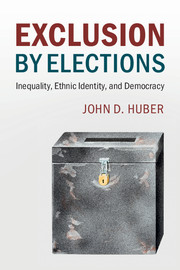Book contents
- Frontmatter
- Contents
- List of Figures
- List of Tables
- Acknowledgments
- 1 Introduction
- 2 Why Worry about Inequality and Ethnic Politics?
- PART I THE THEORETICAL ARGUMENT
- 3 Group Identity and the Politics of Exclusion
- 4 A Theory of Social Structure, Electoral Identities, and Party Systems
- 5 Inequality, Ethnic Divisions, and the Democratic Process
- PART II EMPIRICAL EVIDENCE FOR THE ARGUMENT
- References
- Index
- Miscellaneous Endmatter
5 - Inequality, Ethnic Divisions, and the Democratic Process
from PART I - THE THEORETICAL ARGUMENT
Published online by Cambridge University Press: 18 May 2017
- Frontmatter
- Contents
- List of Figures
- List of Tables
- Acknowledgments
- 1 Introduction
- 2 Why Worry about Inequality and Ethnic Politics?
- PART I THE THEORETICAL ARGUMENT
- 3 Group Identity and the Politics of Exclusion
- 4 A Theory of Social Structure, Electoral Identities, and Party Systems
- 5 Inequality, Ethnic Divisions, and the Democratic Process
- PART II EMPIRICAL EVIDENCE FOR THE ARGUMENT
- References
- Index
- Miscellaneous Endmatter
Summary
Chapter 4 described how ethnic and class identities could be integrated into a distributive theory of elections, where parties form and compete in response to social structure. The central insight from the chapter concerned the interaction of the number of nonrich (nNR) and the number in the majority group (nA). As the party representing the smaller of these two groups has an advantage, whether a class-based or ethnic party wins should be influenced by the relative sizes of these two groups.
This chapter uses the theoretical model to develop substantive expectations about electoral competition and policy outcomes, but I first take up the question of whether it makes sense to treat the number of nonrich as exogenous in the first place. Why can't the winning party simply use policy to determine the number of “nonrich” voters following an election (e.g., by setting an income-based threshold for receiving benefits)? The answer to this question provides part of the answer to a second question posed in this chapter, which concerns measuring the number of nonrich. I argue that the Gini coefficient is an appropriate substantive measure because it emerges analytically from the parameters in the model and because it is related to the types of policies that a class-based party could be expected to implement if elected.
If the Gini is a reasonable proxy for the number of nonrich, what is a reasonable proxy for nA, the size of the majority group? I argue that “ethnic polarization” (EP) is the most appropriate measure of ethnic diversity, with ethnic polarization decreasing as nA increases. Ethnic polarization is preferable to the main alternative, ethnolinguistic fractionalization (ELF), because it more clearly taps the degree to which the size of a majority ethnic coalition departs from a bare majority.
With the Gini coefficient of inequality and ethnic polarization as measures of the central parameters in the model, it is possible to state the main substantive elements of the argument in terms of ethnic diversity and inequality. The interaction of these two variables should be related to the nature of electoral competition, and in particular the importance of income and ethnic identity in voting. And the variables should also be related to the extent to which government policy should redress inequality.
- Type
- Chapter
- Information
- Exclusion by ElectionsInequality, Ethnic Identity, and Democracy, pp. 81 - 98Publisher: Cambridge University PressPrint publication year: 2017



